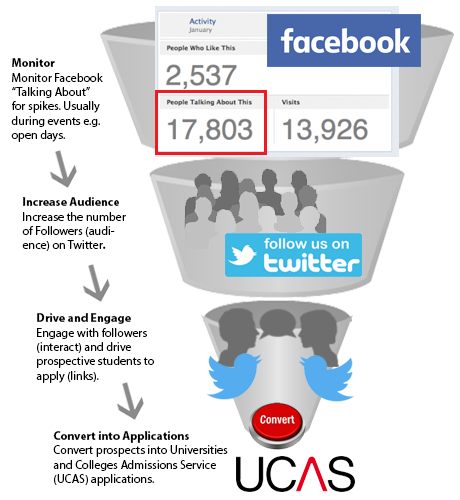This paper was in response to a call for research to explore brand identity, meaning, image, and reputation (BIMIR) in higher education in the Journal of Business Research. The paper was written in collaboration with Stuart Roper and Fiona Lettice. The study set out to determine whether use of social media platforms would raise the value of universities’ brands by increasing demand for places. If social media use were found to improve brand performance, the study would then determine which aspects of social media would be of the greatest value.
Rutter, R., Roper, S. and Lettice, F., 2016. Social media interaction, the university brand and recruitment performance. Journal of Business Research, 69(8), pp.3096-3104. Download PDF
At @UnionUEA there’s something for everyone. Find out more about studying at UEA here: https://t.co/0SUZDd1PpVhttps://t.co/lpZZm8UNZR
— UEA (@uniofeastanglia) May 20, 2016
Figure 1: Example of a Tweet aimed at prospective students by the University of East Anglia (UEA)
Introduction – While many effective methods exist for enhancing brand image, use of social media is increasingly becoming the most common across all sectors, as it allows almost universal access. Although considered controversial in some quarters, Higher Education Institutes (HEIs) have begun communicating in the tone of the marketplace in order to attract students, their de facto customer base, amid inbuilt inequities in both material assets and reputation. Universities with a well-established history of excellence, such as those in the Russell Group, have a significant advantage over newer HEIs or those which are smaller or have restricted access to funding, but the relatively low cost-to-engagement ratio of social media enables all HEIs to embrace it. The research question being: can institutions with lower reputational capital compete for students by increasing their brand presence?
The hypotheses – four possibilities were considered:
- The level of HEI initiated social media activity on Twitter and Facebook positively and significantly relates to student recruitment performance – the first hypothesis would be shown to be correct if a clear connection could be demonstrated between those institutions which initiated a greater amount of social media activity and those which experienced an increase in student recruitment.
- ‘The level of HEI social media validation on Twitter and Facebook positively and significantly relates to student recruitment performance – for the second hypothesis, the connection would need to be made between success in recruitment and numbers of followers on Twitter or likes for HEIs’ Facebook pages and posts.
- The type of tweets, direct user interaction and website links will significantly moderate the relationship between social media followers and student recruitment performance – placing intrinsic value on type rather than amount of engagements, could be shown to be correct through analysis of whether potential students were finding answers to questions, using links supplied via social media and demonstrating satisfaction with their interactions.
- The level of social media use, direct user interactions, website links on Twitter and Facebook Talking About will be significantly different between Russell Group and non-Russell Group HEIs – a difference would have to be shown between the numbers of tweets and/or Facebook Talking About (FTA) relating to those HEIs in the Russell Group when compared to the non-Russell Group, as well as numbers of weblinks and levels of user engagement.
Methodology – Data in the form of Facebook likes, FTA and Twitter followers was manually collected and the Twitter archive of each of the 56 HEIs in the study was harvested using web scraping software. The number and type of each kind of interaction was analysed and the data distribution plotted to show any relevant trends; the information was then examined using structural equation modelling, confirming the consistency of the trends. In order to determine how these results impacted on the hypotheses, the researchers garnered information from the Universities and Colleges Admissions Services (UCAS) showing the number of applications to each HEI per available place. Plotting the recruitment figures from UCAS against the analysis of the HEIs’ social media performance allowed any relationship between the two factors to be observed at distinct points in time and conclusions to be drawn. Figure 2 highlights the scraping process and platforms used in this research.
Figure 2: showing the scraping process and platforms used in the research
Findings – The study shows that high numbers of Twitter followers, Facebook likes and FTA are strong indicators of recruitment performance, with Twitter followers being the most relevant factor. While a greater number of tweets does not predict greater success in recruitment, the type and quality of Twitter interaction is important; as prospective students often engage with HEIs on social media to find answers to specific questions, a swift response is more likely to create a relationship between the HEI and the individual, thereby encouraging recruitment. The amount and type of weblinks posted on social media has no discernible effect on recruitment performance. Hypothesis 4 was only partially correct, as Russell Group universities were neither making a significantly different number of tweets to non-Russell Group universities nor experiencing a higher amount of FTA. Russell Group HEIs were, however, involved in a higher average number of interactions and posted more weblinks, almost exclusively to their own sites, unlike non-Russell Group universities. Figure 3 below summarises how social media can be used to achieve the highest level of UCAS demand.
Figure 3: the social media student recruitment funnel
Conclusion – By engaging with those prospective students who have endorsed the HEI via Facebook likes or by following it on Twitter and making those engagements fast and accurate, social media can become one of the most effective tools at a university’s disposal. Regardless of status, those HEIs that create a strong social media presence can improve their brand image and increase student recruitment.


